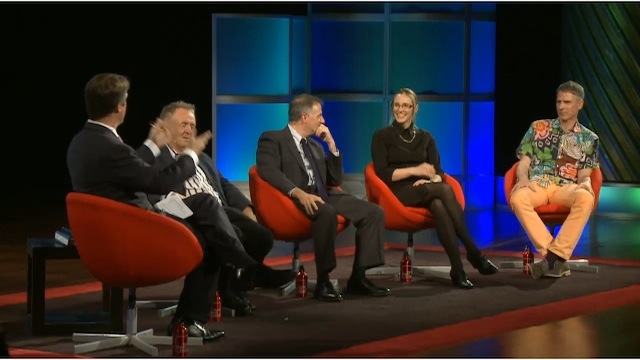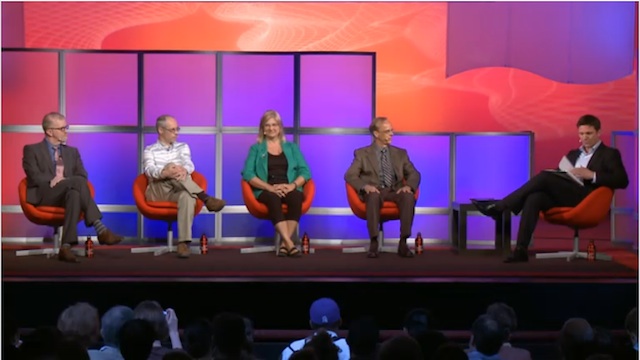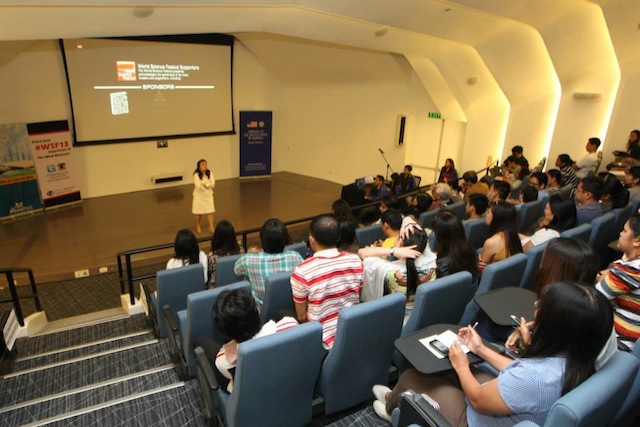SUMMARY
This is AI generated summarization, which may have errors. For context, always refer to the full article.
MANILA, Philippines – What goes on inside our brain—and can technology duplicate it?
Experts tried to dissect these topics during the first-ever remote sessions of the World Science Festival, one of the world’s largest and most prominent science festivals.
Held at The Mind Museum at the Bonifacio Global City in Taguig, two sessions focusing on the human brain were beamed live from New York City.
The first one focused on our understanding of consciousness, while the second session focused on the possibilities of replicating our brain in the form of computers.
The sessions were held on the mornings of May 31 and June 1 (May 30 and 31 in New York), and brought together a crowd of scientists, students, academics, and science enthusiasts.
What is consciousness?

“The conversation we’re going to have tonight is going to be scintillating,” said moderator Terry Moran, a co-anchor of ABC’s Nightline, opening the floor for the first session, entitled “The Whispering Mind: The Enduring Conundrum of Consciousness.” “Maybe a little disturbing.”
What followed was a discussion on “what is consciousness?”
“The basic idea of it is just the things you think of as belonging to your mind,” said Colin McGinn, a philosopher from the University of Miami. “Such as hearing things, seeing things, tasting things.”
Along with McGinn, the panel included Nicholas Schiff, a physician at the Weill Cornell Medical College; Christoff Koch, the chief scientific officer at the Allen Institute for Brain Science in Seattle; and Mélanie Boly, a neurologist at the Belgian National Fund for Scientific Research and at University of Wisconsin-Madison.
The first question of the night was thrown by Moran: “Is the fetus conscious?”
“The issue is, what are we trying to measure when we’re trying to measure consciousness?” said Schiff.
Stimuli was Koch’s answer. As various stimuli cause changes in the developing baby, the baby’s brain changes as well. According to Koch, this goes hand in hand when the baby wakes up and has his or her first conscious sensation.
‘No brain, never mind’
Another highlight in the discussion was the question: if you take a look at the brain, where will you find consciousness?
“There are parts of the brain that seem to be more involved,” said Boly. Without the cerebellum, an arrangement of nerves found at the base of the brain, you wouldn’t be able to walk, but your personality wouldn’t change. However, if you removed a layer of nerves called the cortex, you wouldn’t be the same.
“No brain, never mind,” Koch said in jest. “Unless you can upload yourself.”
At the end of the session, the scientists fielded two questions from their Filipino audience. The first was: “Why haven’t the other species evolved to the point of existential consciousness that humans have?”
“A lot of animals have developed self-consciousness,” Koch said. “They just don’t write books about it because they don’t have language.”
The second question was: “Can you keep the human brain alive outside of the human body? And if you can, how long?”
“I don’t think there’s a good example,” Schiff said.
In good humor, Koch shared, “There’s a company in Las Vegas […] that promises when you die, they’ll decapitate you and quickly deep-freeze you.”
Moran ended the session by asking the scientists if studying human consciousness had changed their lives.
Koch said it was “uplifting,” while Boly said it was “inspiring.” For Schiff, it was about “the human connection.”
“I find it very difficult to answer even some of the simplest questions in philosophy. What does it make me feel?” said McGinn. “It makes me feel very frustrated.”
A blueprint for the human brain

Moderated by ABC journalist Bill Weir, the second session, entitled “Architects of the Mind: A Blueprint for the Human Brain,” tackled the question: “Can a computer simulate the human brain?”
“We can build computers that are like brains,” was cognitive roboticist Murray Shanahan’s answer.
However, the task isn’t as simple as it sounds.
To simulate the brain, we must first map it out. Kristen Harris, a neuroscientist in the Center for Learning and Memory at the University of Texas at Austin, described a years-long experiment she had conducted to map out a minuscule portion of a rat’s brain. If she could do the experiment 8 trillion times over, she could map out the rat’s entire brain.
Unfortunately, trillions of years is time we don’t have. According to Harris, the big problem in mapping the brain is giving scientists the tools to work at a much faster level.
Of course, not all brains are the same. This results in even more problems. In making a computer simulation of the brain, you have to consider what principles can be true of all brains. What’s normal, and what isn’t? These aren’t easy questions to answer, given the complexity of the brain: a single brain cell probably has as much power as a laptop.
“One of the main goals is mapping out connections in the brain,” said R. Douglas Fields, a developmental neurobiologist and author of The Other Brain. “But if we do map out all those billions of connections, will we be able to understand them?”
According to Fields, the glia or the glial cells are where we should look to better understand the brain. Unique to humans, these are the cells that carry brain waves and communicate without electricity. While most activity in brain mapping centers around the nerve cells or the neurons, only 15% of the brain is actually composed of neurons.
To expound on why he preferred glia to neurons, Fields cited a study conducted on Albert Einstein’s brain. It turns out that Einstein’s brain appears, for the most part, completely normal. The difference lay in his glial cells, which were larger and more complex than that of the average human being.
‘Doing calculus, just don’t know it’
Shahanan’s approach to brain mapping focused less on biology and more on technology.
“What we really want to do is scale up and speed up dramatically,” Shahanan said. He noted that everything we’ve seen of the brain so far is separate from the body. According to him, if we were to make computer models of the brain, we should make models that control robots. “Brains evolved in order to make bodies move around in the world,” he explained.
Another aspect of modeling the brain is decision-making.
“We’re doing calculus, we just don’t know it,” said Gregory Wheeler, a computer scientist and philosopher at Carnegie Mellon University, of how we make decisions. “We’re solving differential equations to catch a ball.”
However, unlike a computer would, we aren’t actually solving the equations mentally. We see the ball. We run towards it. We run at a certain speed so that the ball doesn’t get out of our sight. And then we catch it. This intuitive thinking isn’t something that can be translated so easily into a computer program.
How the brain processes memory is also different from how a computer program would. If someone asks us if we’ve been to a place before, we would know instantly if the answer was “yes” or “no”. If you asked the same question of a computer program, the program would have to go through a list of all places you’ve ever been to before it could provide an answer.
“We seem to have a construct of the universe [in our head],” Fields explained. “You know where you’ve been and where you haven’t.”
As the discussion began to wind down, Weir asked: is it likely that we’ll see a future similar to that of the Terminator or the Matrix? Can we build a brain that is conscious, self-aware?
According to Shahanan, the possibility is worth taking seriously. If we can build something that has our cognitive capacities, it only follows that we can go on to build something with cognitive capacities greater than our own. If we program something that can build on its own successes, it can build upon itself without our control.
To illustrate the possibility of consciousness, Shahanan put forth a hypothetical situation: what if you replaced the neurons of a live mouse with artificial ones? Does consciousness disappear, or could it be retained? Shahanan believed the latter.
“Consciousness, I will punt,” Wheeler countered. “We don’t know near enough to engage with those thoughts.”
During the question and answer portion, the panel entertained a question from Manila: “If we program artificial brains, will we have to program the tendency to make mistakes?”
“You have to pick and choose what you remember,” said Harris. The errors are sometimes simply a byproduct of something the brain has to do: filter and forget.

A production of New York-based Science Festival Foundation, the WSF this year took the form of a 3-day series of discussions on topics that have become increasingly relevant to the modern world. The discussions were led by a panel of leaders in their fields.
The remote session at The Mind Museum was made through the efforts of the United States Embassy in Manila.
Mind Museum curator Maria Isabel Garcia said plans are already in the works for them to participate in the festival again next year. – Rappler.com
Add a comment
How does this make you feel?
There are no comments yet. Add your comment to start the conversation.